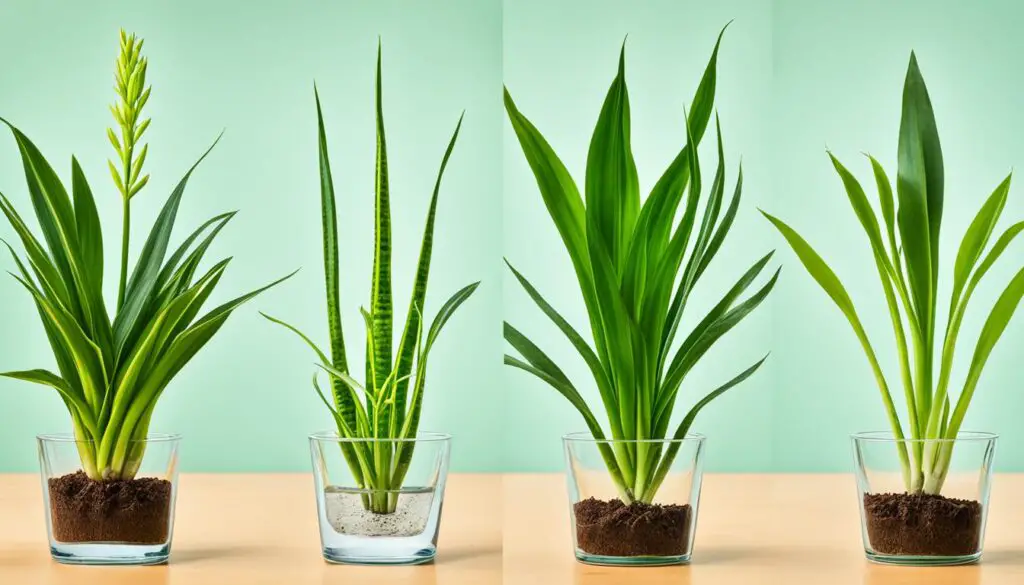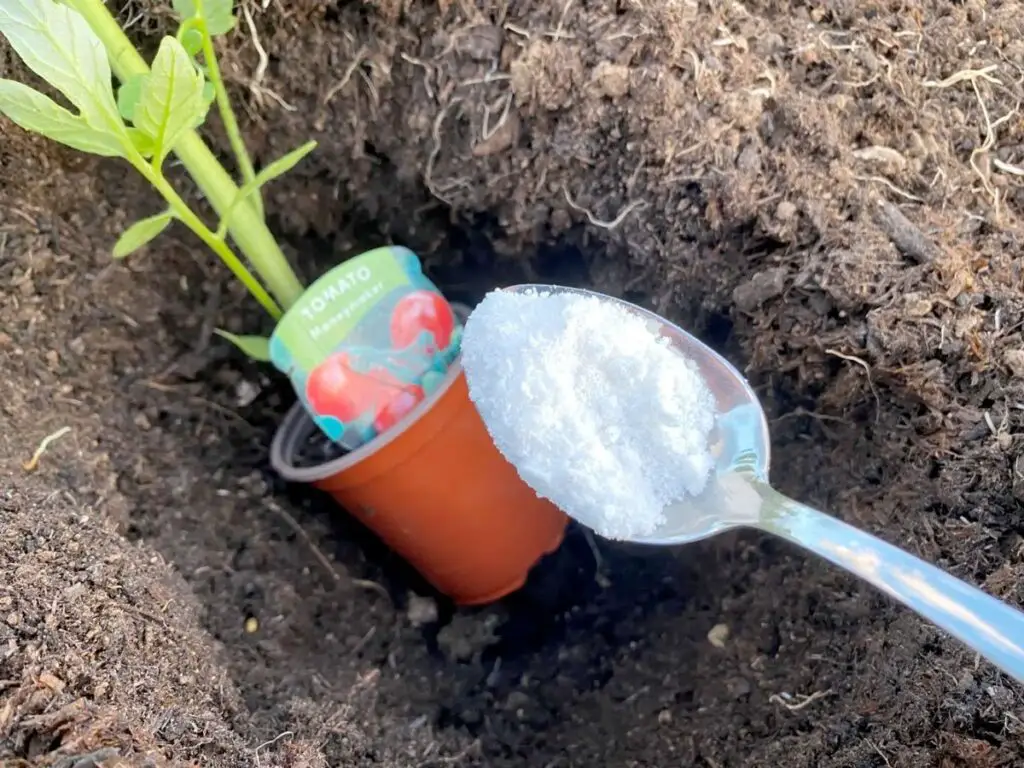Sansevieria, commonly known as snake plants, are beloved for their resilient nature and striking foliage. These hardy houseplants not only purify the air but also thrive with minimal care, making them a go-to choice for plant enthusiasts of all skill levels.
If you’re looking to expand your snake plant collection or share your love of these versatile succulents, propagation is the way to go.
In this article, we’ll explore four simple techniques to Propagate Snake Plant, including water propagation, soil propagation, propagation by division, and rhizome propagation.
Discover the joy of growing your own snake plant army and create a lush indoor jungle with these easy-to-follow methods.

Key Takeaways
- Learn four effective methods to Propagate Snake Plant: water propagation, soil propagation, propagation by division, and rhizome propagation.
- Discover the benefits of multiplying your Sansevieria collection and growing a healthy, thriving indoor garden.
- Explore the best time for propagation and the essential tools and materials needed for each technique.
- Understand the specific steps and considerations for each propagation method to ensure successful snake plant cuttings and new growth.
- Gain insights into the care and maintenance requirements for your newly propagated snake plants.
Propagate Snake Plant: An Introduction
The Snake Plant, also known as Sansevieria or Mother-in-Law’s Tongue, is a popular and low-maintenance indoor house plant renowned for its tolerance to dry, tropical climates and easy propagation.
Propagating a Snake Plant is a simple process that allows you to generate new plants at no cost and share them with friends and family.
What is a Snake Plant?
The Snake Plant is a succulent that belongs to the genus Dracaena, formerly known as Sansevieria.
These resilient plants are native to tropical regions of Africa and Asia, and they have become a staple in many homes due to their ability to thrive in a variety of indoor conditions.
Benefits of Propagating Snake Plants
Propagating a Snake Plant offers several benefits, including:
- Multiplying your plant collection at no cost
- Retaining the unique variegation patterns of the parent plant
- Creating genetically diverse plants that may exhibit different growth habits or leaf shapes
“Propagating Snake Plants is a simple and rewarding way to expand your indoor garden without breaking the bank.”
By propagating your Snake Plants, you can easily share them with friends, family, or even sell them, making it a versatile and cost-effective way to enjoy these resilient and low-maintenance indoor house plants.
Preparing for Snake Plant Propagation
When it comes to propagating your beloved snake plant, timing and preparation are key.
The spring and early summer months are the most favorable time to embark on this rewarding journey, as this coincides with the plant’s active growth phase.
During this period, the snake plant exhibits robust energy, promoting successful propagation. Avoid propagating your snake plant during the dormant winter months, as the plant’s resources may be limited.
Best Time for Propagation
The optimal time to propagate your snake plant is during the spring and early summer months.
This is when the plant is actively growing, allowing for a higher success rate in rooting and establishing new plantlets. By aligning your propagation efforts with the plant’s natural growth cycle, you can ensure a thriving and healthy new generation of snake plants.
Tools and Materials Needed
Propagating a snake plant requires a few essential tools and materials. Gather the following items before you begin:
- Sharp knives, scissors, or pruners to make clean cuts
- A healthy, vibrant snake plant leaf
- Planters or pots with drainage holes
- Well-draining potting soil
- Water for hydration
With these Snake Plant Propagation Tools and Snake Plant Propagation Supplies on hand, you’ll be well-prepared to embark on the exciting journey of When to Propagate Snake Plant.
Water Propagation Method
If you’re looking to propagate your snake plant, the water propagation method is a straightforward and effective technique.
This method allows you to witness the root growth of your plant cuttings, providing a visual representation of the propagation process. To get started, simply snip off a leaf from your snake plant, also known as a sansevieria, close to the soil line.
Place the bottom of the leaf cutting in a container of water, ensuring that you cover about 25% of the leaf. Position the container in an area with indirect sunlight, and you’re on your way to propagating snake plants in water.
One of the advantages of the water propagation method is its simplicity. All you need is a container, some water, and your snake plant cutting.
As the roots begin to develop, you can change the water weekly to keep it fresh and encourage healthy growth. However, it’s important to note that this method may be the slowest of the propagation techniques and may not retain the variegation of some snake plant varieties.
If you’re interested in rooting snake plant cuttings in water, this method is a great option. By following these simple steps, you can easily propagate your snake plant and enjoy the benefits of this resilient and low-maintenance houseplant.

“The beauty of the snake plant lies in its ability to thrive with minimal care, making it a perfect choice for both novice and experienced gardeners.”
Soil Propagation Method
If you’re looking to expand your snake plant collection, the soil propagation method is a reliable and straightforward approach.
This technique involves taking a single leaf from your existing snake plant, known as Sansevieria, and propagating it directly in well-draining potting soil.
Steps for Soil Propagation
- Carefully cut off a single leaf from your snake plant near the soil line.
- Snip the cut leaf into 2-inch pieces, ensuring each piece has at least one node.
- Allow the leaf cuttings to callus over for a couple of days, forming a protective layer.
- Plant the cuttings in a well-draining potting mix, burying the nodes about an inch deep.
- Water the soil lightly and place the container in a warm, bright location.
- Monitor the soil and water as needed, allowing the new plants to take root and establish themselves.
Pros and Cons of Soil Propagation
The soil propagation method for Snake Plant Soil Propagation offers several advantages. It allows you to mix different Sansevieria varieties in a single pot, creating a visually stunning display.
Additionally, you don’t need to worry about keeping the root cuttings submerged in water, as the soil provides the necessary moisture and support for the new plants to grow.
However, one potential downside is that the new plants may not exhibit the same variegation patterns as the parent plant.
Additionally, the root growth is not as easily visible as it would be in a water propagation setup. Nevertheless, with proper care and attention, soil propagation can be an excellent way to Propagate Sansevieria in Soil and Snake Plant Leaf Propagation in Soil.

Propagation by Division
When it comes to propagating your snake plants, division is a fast yet messy method that’s worth considering.
This technique involves dividing the plant’s root clump into individual sections, ensuring that each section has at least three rhizomes, a leafy top, or a snake plant pup attached.
By separating the plant in this way, you can quickly multiply your snake plant collection and create new, vibrant plants from a single parent.
The process of Snake Plant Propagation by Division starts with gently sliding the parent plant out of its pot.
Using a sharp knife or a pair of scissors, carefully divide the root clump into several sections. It’s important to make sure each division has the necessary components to thrive – the rhizomes, leaves, and potentially a snake plant pup.
Once you’ve made the divisions, plant each section into a well-draining pot and water them thoroughly.
One of the key benefits of Dividing Snake Plants is that it allows new leaves to retain the variegation of the original plant.
This means the new plants will have the same striking patterns and colors as the parent, ensuring a cohesive and visually appealing display in your indoor garden.
Additionally, this method is generally faster than propagating snake plants from leaves, making it a great option for those looking to quickly expand their collection.
| Pros of Snake Plant Propagation by Division | Cons of Snake Plant Propagation by Division |
|---|---|
|
|
While Separating Snake Plant Pups through division may be a bit more involved than other propagation methods, the benefits often outweigh the effort.
By carefully dividing your snake plant, you can create new, vibrant plants that will thrive and add to the beauty of your indoor space.

Rhizome Propagation Technique
The rhizome propagation technique is an effective method for propagating snake plants (also known as Sansevieria).
This approach involves utilizing the plant’s underground rhizomes to grow new individual plants. Rhizomes are horizontal stems that grow beneath the soil surface, sending out roots and shoots to expand the plant’s reach.
Advantages of Rhizome Propagation
Propagating snake plants from rhizomes offers several key benefits:
- It’s a fast and efficient way to multiply your Sansevieria collection.
- Rhizome propagation doesn’t require dividing the mother plant, preserving its overall structure.
- This method works particularly well for variegated snake plant varieties, as the new plants will maintain the same color patterns.
To propagate snake plants using the rhizome technique, simply slide the parent plant out of its pot, locate the rhizomes near the root system, and carefully cut off a section of the rhizome.
Allow the rhizome cutting to callus over for 1-2 days before repotting it in well-draining potting mix. With the right care, this rhizome will sprout into a thriving new Sansevieria plant.

“Rhizome propagation is a fantastic way to expand your snake plant collection without having to divide the mother plant.”
By leveraging the snake plant’s natural rhizome system, you can efficiently propagate Sansevieria and enjoy the rewards of growing healthier, happier plants.
Propagate Snake Plant: Care and Maintenance
Proper care and maintenance are crucial for the success of your propagated snake plants. By understanding the unique lighting, temperature, watering, and soil needs of these resilient houseplants, you can help your newly propagated snake plants thrive and flourish.
Lighting and Temperature Requirements
Snake plants prefer bright, indirect sunlight. Aim to provide them with 6-8 hours of bright, filtered light per day.
Avoid direct sunlight, as it can scorch the leaves. Maintain a temperature range of 60-85°F (15-29°C) for optimal growth and development.
Watering and Soil Needs
When it comes to snake plant watering, less is more. Allow the soil to dry out completely between waterings, typically every 2-3 weeks.
Overwatering can lead to root rot, so it’s essential to pay attention to the soil moisture level. Use a well-draining potting mix, such as a cactus or succulent blend with added perlite or pumice, to prevent waterlogging.
| Watering Frequency | Soil Type |
|---|---|
| Every 2-3 weeks | Cactus/Succulent mix with perlite or pumice |
Consider adding a slow-release fertilizer to the soil once or twice a year to support the growth and development of your snake plants. This will ensure they receive the necessary nutrients to thrive.
“Proper care and maintenance are the keys to a thriving snake plant collection.”
Troubleshooting Common Issues
While snake plants, or Sansevieria, are often celebrated for their resilience and low-maintenance care requirements, even these hardy plants can face occasional challenges.
By addressing common snake plant growth problems, pests, and diseases, you can keep your Sansevieria thriving and healthy.
Snake Plant Growth Problems
If your snake plant isn’t growing as vigorously as you’d like, the most likely culprits are insufficient lighting or overwatering.
Snake plants thrive in bright, indirect sunlight, so move your plant to a sunnier spot if it seems stunted. Overwatering can lead to root rot, causing the leaves to yellow and wilt. Stick your finger in the soil and only water when the top inch feels dry.
Snake Plant Pests
- Mealybugs: These white, cottony pests can suck the life out of your snake plant. Wipe down leaves with a damp cloth or treat with neem oil.
- Spider mites: Look for fine webbing and stippling on leaves, then spray with insecticidal soap or introduce beneficial insects to control the mites.
Snake Plant Diseases
Proper drainage and soil selection can help prevent many snake plant diseases. Avoid letting your plant sit in standing water, which can lead to root rot and other fungal issues.
Use a well-draining potting mix formulated for succulents and cacti. If you notice any discoloration or lesions on the leaves, consider treating with a fungicide.
| Common Issue | Potential Causes | Solutions |
|---|---|---|
| Slow growth | Insufficient light, overwatering | Move to brighter spot, adjust watering schedule |
| Pests | Mealybugs, spider mites | Wipe leaves, use neem oil or insecticidal soap |
| Diseases | Root rot, fungal issues | Improve drainage, use well-draining soil, treat with fungicide |
By keeping an eye out for these common snake plant issues and taking prompt, appropriate action, you can help your Sansevieria thrive for years to come.
Grow Happier, Healthier Snake Plants
By following the four proven propagation methods outlined in this article – water propagation, soil propagation, division, and rhizome propagation – you can successfully multiply your Healthy Snake Plants and enjoy a lush, thriving indoor jungle.
Remember to provide the right soil, lighting, and watering conditions to ensure your propagated snake plants grow into Growing Snake Plants.
With a little care and attention, you can create a beautiful and low-maintenance indoor oasis filled with these resilient, air-purifying plants.
By mastering the Snake Plant Propagation Success techniques, you’ll be well on your way to cultivating a thriving collection of these versatile and easy-to-care-for houseplants.
Whether you’re a seasoned plant enthusiast or just starting your indoor gardening journey, these propagation methods will help you grow a healthier, happier snake plant family that will bring joy and natural air purification to your living space for years to come.
FAQ
What is the best time to propagate a snake plant?
The spring and early summer months are the most favorable time to propagate a snake plant, as this coincides with the plant’s active growth phase.
What are the essential tools and materials needed for snake plant propagation?
The essential tools and materials needed for snake plant propagation include sharp knives, scissors, or pruners, a healthy snake plant leaf, planters or pots with drainage holes, well-draining potting soil, and water.
How do I propagate a snake plant using the water propagation method?
To propagate a snake plant in water, snip off a leaf close to the soil line, place the bottom of the sansevieria cutting in water, covering 25% of the leaf cutting, and keep it in sufficient indirect sunlight. Change the water weekly.
What are the benefits of soil propagation for snake plants?
Soil propagation is a reliable and straightforward method for expanding your snake plant collection. It is ideal for mixing different snake plant varieties in one pot and does not require keeping root cuttings in water.
How do I propagate a snake plant by division?
Propagation by division is a fast yet messy method of propagating your root-bound and overgrown snake plants. Slide the parent plant out of the pot, use a sharp knife or scissors to divide the root clump into sections, ensuring each section has at least three rhizomes, a leafy top, or a snake plant pup attached, and plant the sections into well-draining pots.
What are the advantages of rhizome propagation for snake plants?
Rhizome propagation is an effective method for propagating snake plants that is fast, does not require dividing the mother plant, and is suitable for variegated snake plants.
What are the common issues that can affect propagated snake plants?
Common issues that can affect propagated snake plants include insufficient light, overwatering (leading to root rot), and pests like mealybugs or spider mites. Proper drainage and soil mix selection can also help prevent and combat plant diseases.



